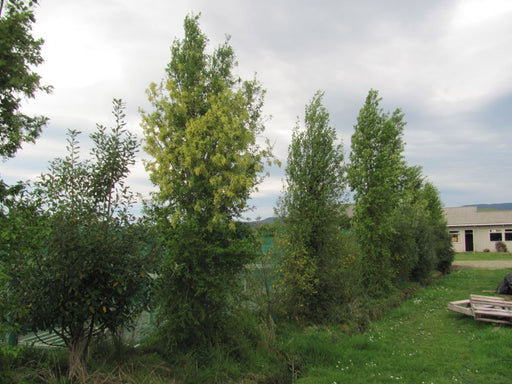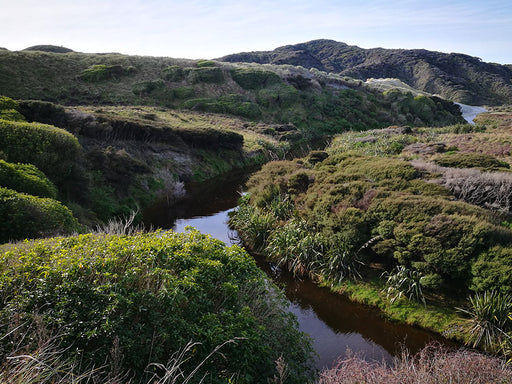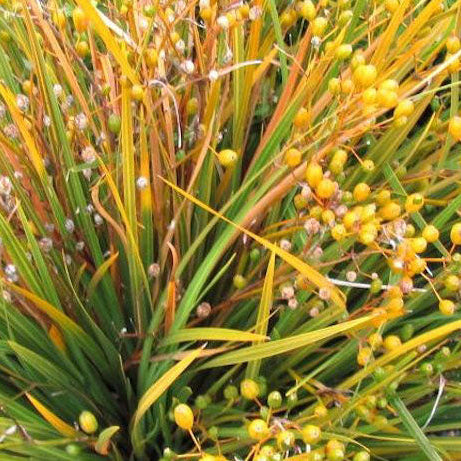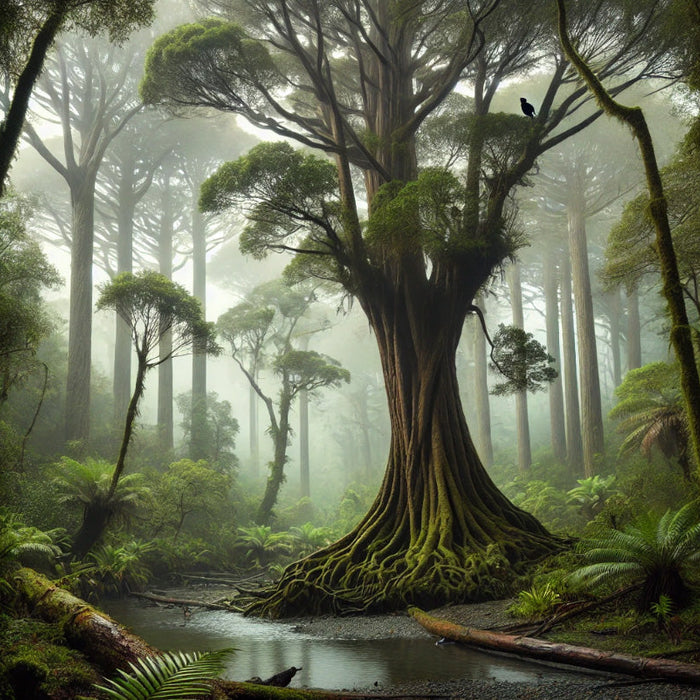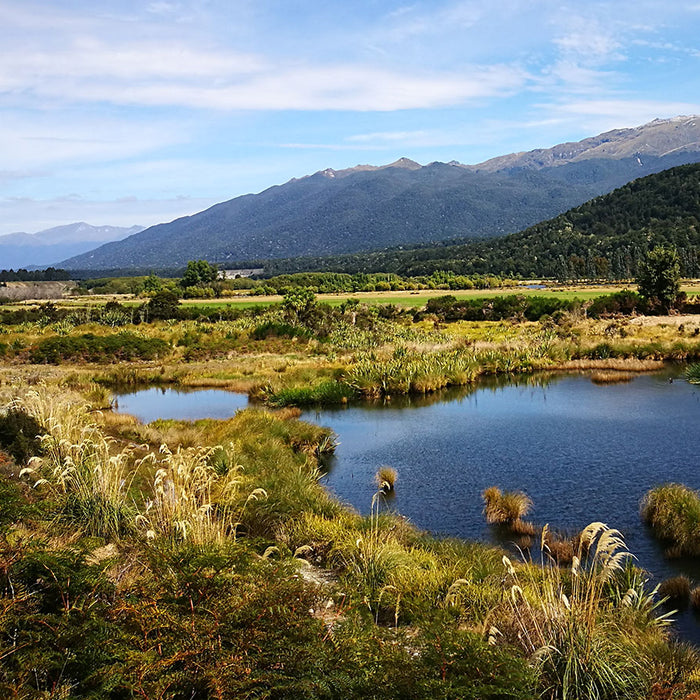Why Wet or Poorly Draining Sites Matter — and Why Choose Natives
Wet or poorly draining soils — including swales, depressions, gullies, riparian edges, or heavy clay flats — present unique challenges for gardeners. Water can pool on the surface, roots can suffocate, and some plants fail to thrive in consistently damp conditions.
Many exotic plants struggle in waterlogged or slow-draining soils, often suffering root rot or stunted growth. Native New Zealand plants, however, have evolved in wet habitats and often tolerate or even thrive in damp or saturated soils. They develop specialized root systems, tolerate low oxygen conditions, and can stabilise soil, reduce erosion, and support wetland ecosystems.
These wet-soil natives are ideal for creating low-maintenance gardens, riparian plantings, or wetland restoration areas while also providing habitat for birds, insects, and other wildlife.
Choosing What to Plant: Match Plants to the Wet Soil Situation
Wet or poorly draining sites vary — from permanently saturated soils to seasonally damp flats, gullies, or riparian margins. Plant selection should match the degree and duration of wetness, sun exposure, and soil type.
Permanently Wet or Waterlogged Flats
 Conditions: soils that remain saturated year-round or for long periods, such as wetlands, pond edges, or waterlogged depressions.
Conditions: soils that remain saturated year-round or for long periods, such as wetlands, pond edges, or waterlogged depressions.
Good native plant choices:
-
Phormium tenax (Harakeke / NZ flax) — thrives in consistently wet soils, excellent for pond edges, swales, and stabilising damp ground.

-
Kahikatea (Dacrycarpus dacrydioides) — iconic swamp tree; thrives in heavy, wet soils.

-
Coprosma propinqua — handles periodically flooded conditions.

Why these work: These plants tolerate prolonged soil saturation, stabilise the soil, and improve water filtration, making them ideal for wetlands or pond margins.
Seasonally Wet Flats or Depressions
 Conditions: areas that flood or remain damp during rainy seasons but dry out partially during summer or drought periods.
Conditions: areas that flood or remain damp during rainy seasons but dry out partially during summer or drought periods.
Good native plant choices:
-
Juncus edgariae — thrives in wet or damp areas, making it an ideal choice for water features, pond edges, and wetland restoration projects. It is especially valued for its low maintenance and adaptability to a range of moist soils.
-
Cordyline australis (Cabbage Tree / Ti Kouka) — high tolerance for wind, salt, frost, drought and wet.

-
Phormium tenax purple — adaptable to seasonal wet soils, stabilising ground while remaining resilient in dry periods.
-
Corokia ‘Yellow Wonder’ — a shrub that tolerates wet soil for part of the year but can also manage drier intervals.

Why these work: They can withstand both wet and temporarily dry conditions, stabilise soil, and provide structure and ecological value in variable water regimes.
Wet Gullies, Streamsides & Riparian Margins
 Conditions: areas with slow-draining soil along gullies, creeks, or stream edges; sometimes shaded, often nutrient-rich but damp.
Conditions: areas with slow-draining soil along gullies, creeks, or stream edges; sometimes shaded, often nutrient-rich but damp.
Good native plant choices:
-
Corokia 'Bronze Knight' — known for its dense, mounding habit, this plant offers year-round interest and works beautifully as a structural element or filler in mixed borders and native gardens.

-
Pittosporum tenuifolium — tolerant of damp soils, suitable for gullies or riparian plantings.

-
Coprosma robusta — stabilises soil along wet gullies and streams, providing shelter for wildlife.
-
Astelia Fragrans — commonly found in damp forest areas across New Zealand, it adds strong form and a lush, architectural look to native gardens. Its fragrant, small flowers and resilience in shade make it a valuable understorey species or feature plant in cooler, sheltered spots.
Why these work: They tolerate wet conditions, stabilise riverbanks or gully edges, and help prevent erosion while providing habitat for birds and insects.
Signature Wet-Soil Natives
 These species are consistently reliable across a range of wet or poorly draining soils:
These species are consistently reliable across a range of wet or poorly draining soils:
-
Phormium tenax (Harakeke / NZ flax) — water-tolerant, excellent for edges, wet flats, or riparian zones.

-
Carex secta (Makura) — tall sedge suited to wet or swampy conditions.
-
Juncus species (rushes) — adaptable for damp or seasonally flooded soils.

-
Griselinia littoralis — shrub/tree for damp gullies, riverbanks, or wet clay flats.
-
Coprosma robusta — versatile shrub for wet soils, stabilising ground and supporting wildlife.
Practical Planting & Care Tips for Wet or Poor-Draining Soils
1. Site Preparation & Soil Improvement
Where water tends to pool, consider slightly raised mounds, swales, or contouring the ground to improve water flow. For clay-rich or compacted wet soils, carefully loosen the soil without over-disturbing it, preserving natural drainage channels. Adding organic matter such as compost or well-rotted mulch can improve soil structure, aeration, and microbial activity while still allowing the soil to retain moisture.
2. Mulching
Use mulch around plants to regulate moisture, reduce erosion, suppress weeds, and prevent soil crusting. In wet soils, keep mulch slightly away from plant stems to avoid fungal problems, while still covering surrounding soil to maintain a balanced moisture level.
3. Best Planting Time
Plant in early spring or autumn, when soils are workable and water levels are moderate. Avoid planting immediately before long wet periods that could drown young roots or in midsummer during drought for seasonally wet areas.
4. Watering and Establishment
Many wet-soil natives require little supplemental watering once planted. Check moisture levels during establishment, especially on raised beds or swales, ensuring roots are well-established. Plants adapt naturally to wet or fluctuating conditions once mature, but young plants benefit from careful monitoring.
5. Spacing, Grouping & Microclimates
Allow space between plants for air circulation, which helps prevent fungal issues in damp soils. Group species with similar moisture tolerance together — sedges and rushes in wetter zones, shrubs on slightly drier raised spots — to enhance survival and create resilient plant communities. Contour plantings along water flow or gradient lines can help stabilise soil and distribute water effectively.
6. Long-Term Benefits of Wet-Soil Natives
Once established, wet-soil natives become low-maintenance, resilient, and ecologically valuable. They stabilise banks and waterlogged flats, improve soil structure over time, reduce erosion, and provide habitat for native birds, insects, and other wildlife. Planting these species supports biodiversity and creates functional, sustainable landscapes that can handle challenging wet conditions with minimal intervention.
Planning Your Wet-Soil Garden (Anywhere in NZ)
1. Survey Your Site
Observe drainage, water retention, seasonal wetness, slope, sun exposure, and shelter to understand your wet-soil conditions.
2. Classify Your Wet Soil Zone
Determine if your site is:
-
permanently waterlogged,
-
seasonally wet, or
-
a wet gully or riparian edge.
3. Select Plants Matching Conditions
Choose from:
-
wet-soil specialists (Phormium, sedges, rushes),
-
moisture-tolerant shrubs and trees (Griselinia, Coprosma, Pittosporum),
-
flexible natives that can handle wet/dry cycles (Phormium, Coprosma robusta).
4. Prepare the Soil
Loosen, amend with organic matter, and shape the site to improve water flow and reduce stagnant areas. Use mulch to retain balanced moisture and prevent erosion.
5. Plant in the Right Season
Early spring or early autumn ensures root establishment before extreme waterlogging or dry periods.
6. Water During Establishment, Then Adjust
Monitor young plants for moisture stress. Once established, most wet-soil natives adapt naturally to fluctuating water levels.
7. Build a Balanced, Layered Garden
Use a mix of groundcovers, sedges, shrubs, and trees to stabilise soil, manage moisture, and create ecological diversity and habitat for wildlife.










